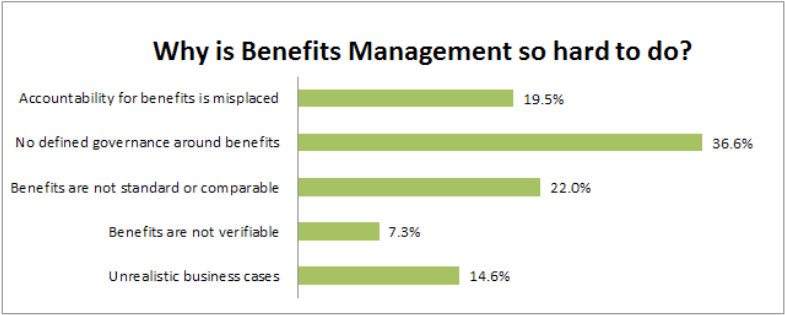I'll be frank: If you aren’t managing the benefits expected from a project (assuming they were identified before the project commenced). the probability of them being realized is low.
It's incredibly important to ensure a project's benefits are top-of-mind throughout its lifecycle - not just thrown in at the end.
Manage Project Benefits – Not Just Deliverables!
Less than 40% of project managers are held accountable for delivering benefits of a project to the business, according to survey results reported in Project Management Institute’s report, “The Strategic Impact of Projects.”
What?! Wait a minute. Project managers are responsible for delivering deliverables – isn’t that the same thing?
Well, no. So, what is the difference between a project deliverable and a project benefit?
- A project deliverable is any unique and verifiable product, result or capability to perform a service that is required to be produced to complete a process, phase or project. Deliverables are typically tangible components completed to meet the project objective, as defined by Project Management Institute, PMBOK Guide®, 5th Edition
- A project benefit, though, is an outcome of an action or decision that contributes toward meeting one or more business objectives, according to business-case-analysis.com
Imagine if you never managed the products (aka the deliverables) of your marketing projects. Odds are, you wouldn’t finish any – or, best case, the deliverables would be incomplete or subpar in quality. It stands to reason that if you don't manage the project's expected benefits, there is a small chance of them being realized at project completion.
Not surprisingly, in the same PMI report referenced above, 75% of respondents said, yes, they do identify the benefits expected at the start of a project. But over 80% said they don’t realize those benefits.
The Benefit of Benefits Management
According to research shared in his LinkedIn post, program and change management expert Soren Porskrog, states that “ we on average realize 25% of the expected value when our focus is cost and deliverables, versus 75% of expected value when our focus is on generating benefits. ”
Holy smokes! That’s a whole lot of money (or market share or incremental client value, or, or, or…) left on the table.
So, for example, if the next phase in your Revenue Marketing maturity path is Account Based Marketing, and your program for the year is a $500,000 line item in the marketing budget, and your expected revenue from the program is $2 million...
...Benefits Management’s impact on the project could mean a slide in your executive deck showing marketing’s revenue contribution at $1.5 million or, well, one third of that.
(Can you say, “in the doghouse”?)
Kind of makes figuring out Benefits Management a no-brainer, doesn’t it?
What To Do Next (and Next)
Benefits management is hard. But the rewards, as you see above, are well worth it. A Project Management Times poll identified some top reasons why it doesn’t get done:

Assuming benefits have been identified, agreement reached between executives and project management on what they are, and a sponsor is on board, next steps could be:
#1 - Assign resources to the effort. Benefits Management is management. It takes attention for the duration of the project – and longer. If you don't have someone who owns this, it'll likely get lost in all of the "things" you have to do!

#2 - Document governance. Project governance isn’t very well defined, but I like this perspective (chart) from the United Nations.
- What are the rules?
- Are they efficient, sufficient, effective, reasonable?
- Who is responsible for what and where does the buck stop?
- What tools or templates are required?
A Benefits Register is a good place to start getting it all down. Its purpose is similar to a Requirements or Risks register, i.e. a place to track stakeholders, changing conditions, progress toward goals (not deliverables), etc.
#3 - Define precisely how the benefits are going to be measured.
- Tangibles are easier, e.g. 100 new opportunities within 6 months.
- Intangibles, not as simple – but you still need to manage attaining them.
Meet regularly with appropriate stakeholders to track any evidence of risk and course correct as appropriate. This could be daily or weekly, but a regularly scheduled meeting is necessary.
#4 - Communicate regularly
Keeping everyone oriented to the same goal is always key to a project's success ... so do the same with your outcomes! If everyone knows their progress, it fosters stronger teamwork as each person takes ownership of their part of the goal.
#5 - Enjoy the adulation that comes with success!
Conclusion
Benefits Management is a hard, but necessary, undertaking to improve the probability of the business success of any project. It’s also logical. If you aren’t keeping the project aligned with the intended business benefits, you cannot proactively correct the course.
Executives don’t like surprises. Keep your eye on the target (not just the project schedule) – and stay out of the doghouse.
Like this post? You can find more great content on our Resources page!



